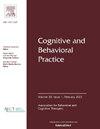在强迫症治疗中使用增强暴露和反应预防程序:病例报告
IF 2.9
3区 心理学
Q1 PSYCHOLOGY, CLINICAL
引用次数: 0
摘要
本病例报告描述了一名21岁男性强迫症(OCD)的评估和治疗,采用强化暴露和反应预防(ERP)治疗方案。患者及其父亲在连续10个工作日每天接受2小时的ERP治疗,并每月进行随访。除了精简的治疗计划外,ERP程序也被用于处理持续的家庭冲突和抑郁症状。据我们所知,这是第一个将这种治疗适应纳入强迫症成人强化ERP背景下的研究。结果表明,目标行为在2周强化治疗期间有所下降,并在4个月的随访期间保持不变。患者及其父亲报告的辅助结果包括更频繁地参与日常生活活动和改善家庭沟通。这项研究的结果为建立ERP会话频率的建议提供了重要的一步,特别是在有合并症的患者中。本文章由计算机程序翻译,如有差异,请以英文原文为准。
Use of an Augmented Exposure and Response Prevention Procedure in the Treatment of Obsessive-Compulsive Disorder: A Case Report
This case report describes the assessment and treatment of a 21-year-old male with obsessive-compulsive disorder (OCD) using an intensive exposure and response prevention (ERP) treatment program. The patient and his father received daily 2-hour ERP sessions delivered across 10 consecutive weekdays, and monthly follow-up appointments. In addition to the condensed treatment schedule, ERP procedures were augmented to address ongoing family conflict and depressive symptoms. To the best of the our knowledge, this is the first study to include such treatment adaptations within the context of intensive ERP for an adult with OCD. Results indicated target behaviors decreased over the 2-week intensive treatment phase and were maintained during 4 months of follow-up. Ancillary outcomes reported by the patient and his father included more frequent engagement in activities of daily living and improved family communication. Outcomes of this study provide an important step toward establishing recommendations regarding ERP session frequency, especially among patients with comorbid disorders.
求助全文
通过发布文献求助,成功后即可免费获取论文全文。
去求助
来源期刊

Cognitive and Behavioral Practice
PSYCHOLOGY, CLINICAL-
CiteScore
4.80
自引率
3.40%
发文量
118
审稿时长
84 days
期刊介绍:
Cognitive and Behavioral Practice is a quarterly international journal that serves an enduring resource for empirically informed methods of clinical practice. Its mission is to bridge the gap between published research and the actual clinical practice of cognitive behavior therapy. Cognitive and Behavioral Practice publishes clinically rich accounts of innovative assessment and diagnostic and therapeutic procedures that are clearly grounded in empirical research. A focus on application and implementation of procedures is maintained.
 求助内容:
求助内容: 应助结果提醒方式:
应助结果提醒方式:


